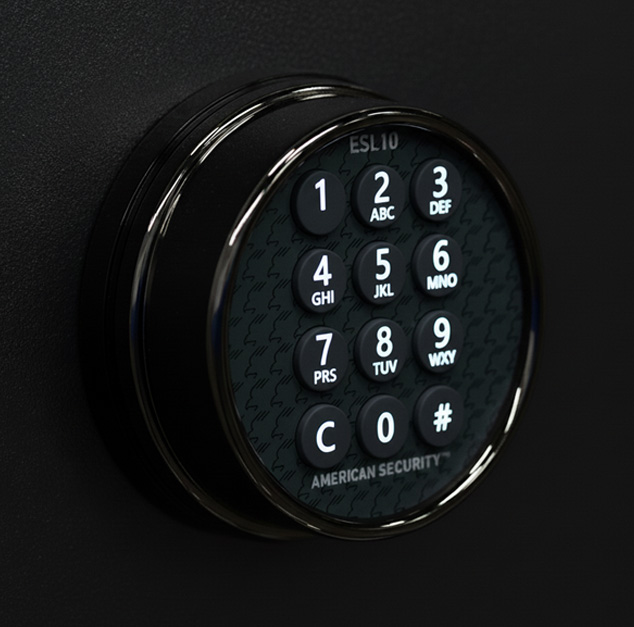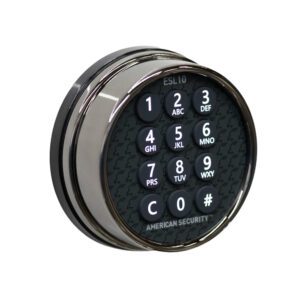While the safe body, lock, and fill materials often get the most attention when evaluating a fire-resistant safe, door seals play an equally critical role in overall fire protection. A high-quality seal can be the deciding factor between losing and saving valuables during a fire.
When exposed to high heat, some seals are designed to expand, creating an additional barrier against smoke, flames, and extreme temperatures. This added layer doesn’t just slow down heat transfer; it also limits smoke intrusion, which is often just as damaging to sensitive documents, firearms, and other valuables as fire itself.
In this guide, we’ll break down the different types of safe door seals available today, highlight the ones we recommend most, and provide examples of American Security safes that incorporate these protective features.
Intumescent Door Seals
Intumescent seals are among the most widely used fire-protective seals in the safe industry. These seals contain special materials that chemically react to heat exposure. Once temperatures reach a certain threshold, the seal expands many times its original size, filling in gaps around the safe door.
Intumescent seals can expand to roughly 6-7 times its size once it’s been exposed to 500°F. This swelling action effectively blocks fire, smoke, and hot gases from penetrating the safe’s interior. Because of their reliability, intumescent seals are commonly found in fire-rated safes designed to protect items such as documents, cash, firearms, and other valuables.
Some key advantages of intumescent door seals include:
- Automatic Protection: Expansion begins without any manual action when exposed to heat.
- Enhanced Fire Resistance: Helps maintain the safe’s internal temperature at survivable levels for a longer period of time.
- Smoke Reduction: Prevents harmful smoke and fumes from damaging contents.
A common brand of intumescent seals is called Palusol, and many American Security fire safes feature this as part of their fire protection, giving owners peace of mind that their valuables have an added line of defense in case of disaster.
Our BF series are constructed with intumescent seals, and include many other security features that make it a solid home safe option.
BF1512
- UL fire rating of 60 minutes at 1700°F
- UL RSC Level I burglary rating
- Seamless Fire-Resistant Clay Fill
- Intumescent Door Seal
- Made in the USA
Dual Seal Systems
While intumescent seals on their own provide excellent fire protection, many high-end safes take it a step further with dual seal systems. These systems pair an intumescent fire seal with an additional silicon seal designed for smoke or moisture resistance.
The benefit of a dual system is an extra layer of protection. Think of the silicon seal as the first line of defense for your safe door, as it typically holds up until temperatures reach 500°F, at which time it starts to degrade. Once temperatures reach that point, the intumescent seal takes over. It activates around 500°F and expands up to six or seven times its original size, creating a tight barrier that shields your valuables from smoke, fire, and heat.
Dual seal systems are especially valuable for safes intended to protect firearms, heirlooms, or sensitive paperwork. Smoke damage can render documents unreadable and corrode firearm finishes long before flames reach them, which is why combining seals is so effective.
American Security’s BFII Series is a great example of this design. By combining intumescent and secondary seals, these safes deliver an added layer of security that performs under both everyday storage conditions and during catastrophic events. It’s the perfect option if you’re looking for a formidable gun safe door seal for your extensive firearm collection.
BFII6024
- ETL fire rating of 120-minutes at 1200°F
- Only gun safe with a UL RSC Level II security rating
- Dual Door Seals
- Made in the USA
Keep in mind, there are also some seals in the safe industry that combine intumescent and silicon seals all in one solution. Make sure to always evaluate what seal is featured in the safe you’re considering. A professional safe dealer can also help walk you through what options are available for the size, design, and safe model you’re looking for.
Moisture-Blocking Seals
For many safe owners, moisture is a common concern. High humidity can cause mold, mildew, and rust, particularly problematic for firearms and metal valuables. Even in climates where fire is less of a concern, excess moisture inside a safe can cause long-term, irreversible damage.
Moisture-blocking seals are typically made from materials like rubber, polypropylene, or nylon. While they’re effective at keeping out moisture, keep in mind that they aren’t designed to provide significant protection against high temperatures, so they may not be the best choice if fire resistance is your top priority.
Moisture-blocking seals are engineered to limit humidity seeping through from the external environment and into the safe’s interior. While they can’t fully replace tools like dehumidifiers, they create a strong first line of defense by minimizing how much external air can penetrate inside.
Some advantages of moisture-blocking seals include:
- Reduced rust and corrosion risk for firearms and metal goods.
- Better preservation of paper documents and photographs.
- Support for climate control tools like dehumidifiers by keeping moisture levels stable.
For owners in coastal or high-humidity regions, safes with moisture-blocking seals are highly recommended. When paired with a dehumidifier, this combination offers one of the best defenses against moisture damage available.
How Door Seals Help Protect What Matters Most
When it comes to safeguarding valuables, firearms, or important documents, the door seal is far more than a simple accessory; it’s a critical component of your safe’s protective system. From intumescent seals that expand under heat, to dual systems that add extra layers of security, to moisture-blocking seals that prevent corrosion and mildew, the right door seal can make all the difference in an emergency.
Choosing the best seal for your safe depends on your unique needs: the items you’re storing, your environment, and the level of protection you want against fire, smoke, and moisture. By understanding the different seal options and how they work, you can make informed decisions that enhance the overall security and longevity of your safe.
Investing in a safe with high-quality door seals (like those featured in American Security models) ensures that your valuables are not only locked away but also protected against the elements that matter most. True home security goes beyond the safe’s lock, and the door seal can make the biggest difference during intense, unexpected conditions.
Browse American Security’s safes, the different seals that have, and we’re positive you’ll find one that fits your needs. However, if you’re still unsure on the best option, don’t hesitate to reach out to our team or find a dealer near you and they can help you come to a final decision!





